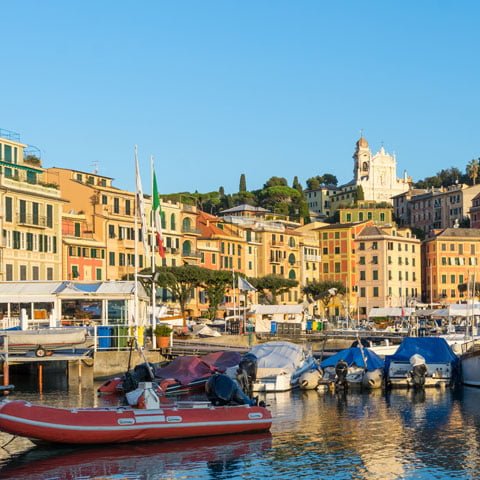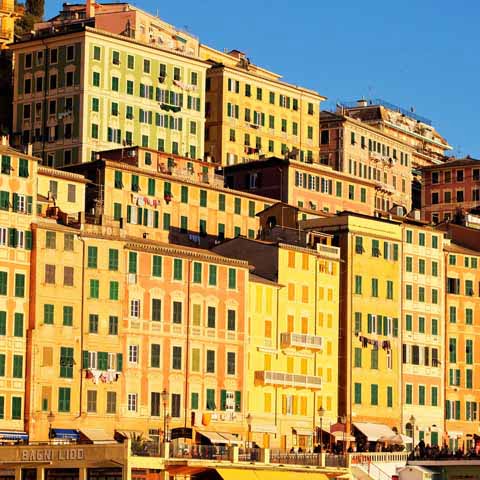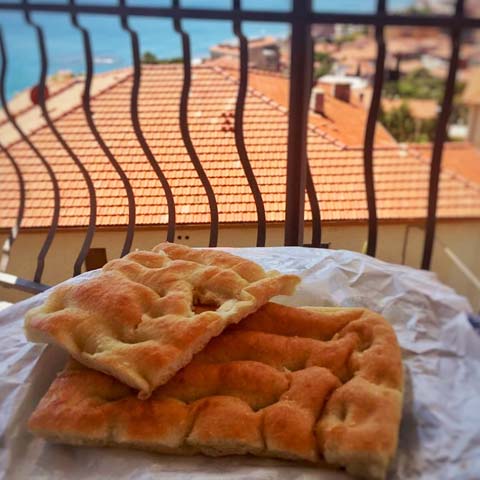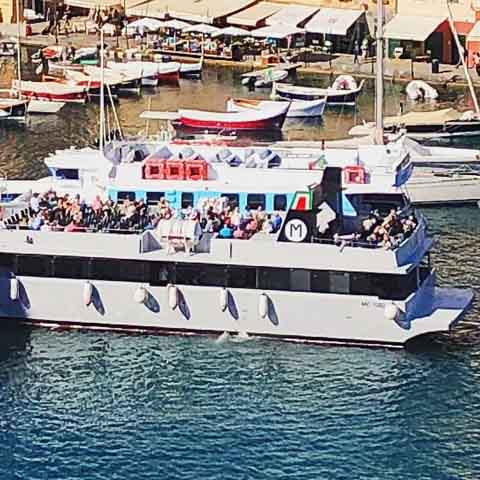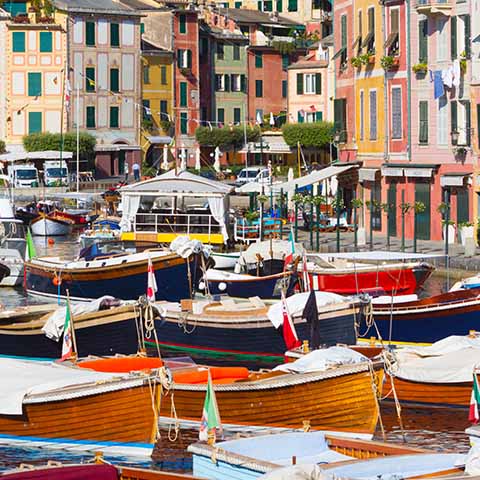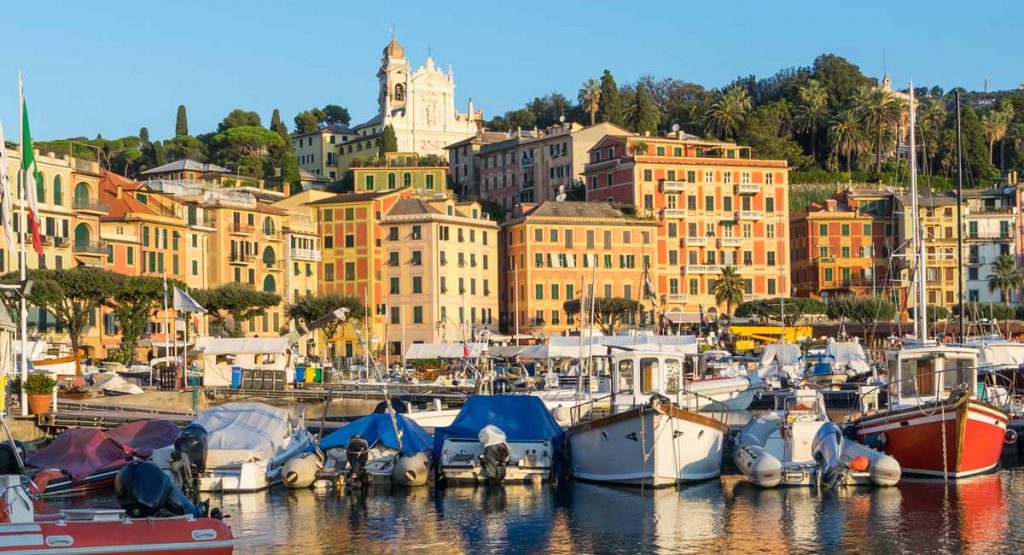Rapallo is a small Italian municipality included in Genoa’s metropolitan area. Counting approximately 30,000 inhabitants, this urban area extends throughout the Gulf of Tigullio and has always played a major role in the history of the region.
Synonymous with wild and indiscriminate urbanization, Rapallo benefited from its strategic position over the centuries. The municipality is located in the western part of the gulf, a territory crossed by many waterways and minor rivers. This position attracted many civilizations, which developed settlements corresponding to today’s hamlets scattered throughout the territory.
Reachable by land and by sea, Rapallo has always offered its inhabitants multiple ways of living, from trade to agriculture.
The origins of the city’s name or its true meaning are still uncertain. According to some historians, it is safe to assume the name derived from ra palù, an archaic definition of a swampy area. This derivation would undoubtedly approach the primitive geological concept of the swamp present at the mouth of the Boate River, the same area where the first settlement was developed in the region.
According to other historians, including the Ligurian Gaetano Poggi, the name derives instead from rapa-lo, a term used to designate a territory where turnips were cultivated.
According to another widely accepted variant, supported by the glottologist Giulia Petracco Sicardi, the name would derive from the Gothic term rappa, which passed into the Italian dialects with the meaning of wrinkled. Supposedly, the name would refer to the actual morphology of the territory.
PREHISTORY OF RAPALLO
Despite its ancient history, Rapallo preserves little evidence from its prehistoric times. It is assumed that the first settlement dates to around 700 BC, as is indicated by a burial site discovered in 1911 in the current district of Sant’Anna.
During the excavation of clay to supply the nearby kilns, archaeologists discovered several sacred objects including a terracotta cinerary urn decorated with a pre-Christian cross symbol and containing an iron spear cusp. Other findings included vases and a gold snake bracelet, indicating the high social position of the bearer.
Studies carried out on the discoveries indicate the first civilizations to establish in the territory were either Etruscan or Greek. However, despite the exceptional discovery, the archaeological material was subsequently lost.
This resulted in both the impossibility to define the certain origin of the people and the impossibility to compare this material with the prehistoric findings discovered in the nearby Chiavari necropolis in the sixties.
What is certain though, is that regardless of which were the first civilizations to settle in the region, Rapallo gained the attention of
Rome. The Romans, driven by their interest in controlling all trade and military routes, established themselves in the region, although evidence of their passage is also scarce.
HISTORY OF RAPALLO
Taking advantage of the struggles that shook the Roman Empire in the fifth century AD, the Lombards conquered Liguria and placed a military detachment between Zoagli and Rapallo, intended as a defensive post against Byzantine rivals.
In parallel, the monks of the Order of San Colombano started the first evangelization of the people, while the Ambrosians built the first Christian temple, the Ambrosian parish church of Santo Stefano, one of the oldest churches in Liguria.
The Lombards ruled the region for about a century; following their defeats against the Franks in 774, Charlemagne, the former ruler of the Franks, assumed the title of King of the Franks and Lombards.
As it is easy to imagine, the arrival of the Franks brought substantial change in the political framework within the Maritima Italorum Province, an administrative subdivision roughly corresponding to today’s Liguria. In an attempt to change the established rules, the Franks founded the county of Genoa, which included the village of Rapallo.
The name of the village appears for the first time in a notarial deed in 964 that attests to the sale of the land to the rulers. A document from 1070, instead attests to the involvement of Rapallo in defending the territory from a sea attack by Pisa, who was seeking political revenge against its historic rival, Genoa.
Despite the defeat, Pisa did not give up its intention to conquer the territory of Genoa and engaged in further struggles. During these events, Rapallo received the chance to prove its fidelity towards Genoa again, giving two galleys to Genoa in an attempt to counter the power of the naval fleet of Pisa.
These events drew the admiration of Genoa, who granted Rapallo the title of free commune under its own protection.
Rapallo transformed into a true local power; as some geographical maps and historical sources confirm, the geopolitical formation of the original municipal territory in the early Middle Ages was much larger than the current one and was constituted not only by Rapallo, but also by Santa Margherita Ligure and Portofino.
At the beginning of the eleventh century, the Republic of Genoa divided its dominions into podesterie; during this division, the
Podesteria of Rapallo was established, comprising the main villages of Santa Margherita Ligure, Portofino, Lavagna, and Cicagna.
The inclusion of Lavagna in the jurisdictional territory of Rapallo created a contrast with the Fieschi family, who became the counts of Lavagna. After around two decades of struggles, the territory was further divided and the Podesteria of Chiavari emerged, to which Lavagna was assigned.
Proving its strong connection with Genoa and following the events, Rapallo’s inhabitants made an oath of absolute loyalty and complete dedication to the Republic of Genoa on March 17, 1229. The oath ensured Rapallo total defensive protection.
Always loyal towards Genoa, in the second part of 1284, the galleys of Rapallo and its men joined the victorious fleet of Genoa against the navy of Pisa in the Battle of Meloria, despite the devastating events that shook the entire region earlier that year during a long siege against the Republic of Venice, Pisa’s ally.
Towards the middle of the thirteenth century, the historical chronicles attest to the presence of leprosy in the village. The disease led to the death of thousands, but the tragedy also led to the establishment of the first temporary shelter for the sick outside the historical core of Rapallo, in today’s town of Bana.
Severely affected by the illness, Rapallo was forced to engage in further military events towards the end of the century when the town was invaded by the powerful naval fleet of the Aragonese. The over four thousand soldiers attempted to push the people against Genoa, which was now ruled by the Sforza.
Only days after the first assault, Rapallo also witnessed the arrival of Swiss soldiers instructed to fight against the Aragonese. The town became the scene of bloody clashes between the two rivals but had no power to fight back the intruders.
Luckily though, Genoa raised its naval power against the French and freed the town in 1495.
But the grim times did not end for Rapallo. Towards the end of the following century, the region became a victim of the plague; the new disease also took its toll on the inhabitants, with the entire region registering about 100,000 deaths.
Nevertheless, the region still underwent a continuous increase of the population, which contributed to strengthening the strategic importance of Rapallo. Genoa then granted the town the title of Capitaneato, an administrative form that enjoyed many more privileges than a Podesteria.
Following the events, the competent jurisdiction of Rapallo was considerably extended; at the same time, the town also started to expand its territory beyond the original city walls, giving life to the historic districts of Rapallo, including Olivastro, Oltremare, and Pescino.
In the fifteenth century, the entire region of Genoa was once again hit by the plague. But Rapallo knew how to defend itself this time and suspended commercial and social exchange with all the other municipalities in the territory, including Genoa. Armored and isolated, Rapallo came out untouched by the disease, an event considered “miraculous” by the inhabitants and attributed to the divine protection of the Virgin Mary, who was designated the patron saint of the town.
The sixteenth century saw Genoa involved in the Austrian War of Succession, which indirectly caused the establishment of a local Austrian occupation garrison in Rapallo. A revolt of the Genoese troops succeeded to free the territory, but soon after, the town became involved in the struggles against the French.
Napoleon Bonaparte succeeded in annexing the Gulf of Tigullio, Rapallo included, to the First French Empire. Rapallo was designated on April 28, 1798 as the capital of the jurisdiction of Tigullio, part of the first French canton under the new legal system.
Under the French domination, the previous orders and religious institutes were suppressed, and in some cases, works of art and furnishings were removed from their place while the original uses of the buildings were transformed.
In the same year, Rapallo’s territory saw the first separatist movements of Santa Margherita, San Siro, San Giacomo di Corte and others, which were integral parts of the municipality of Rapallo, and were grouped under the municipality of Santa Margherita of Rapallo, then transformed by royal decree into Santa Margherita Ligure.
In 1799, the town became the scene of fierce clashes between the French and Austrian armies. The Austrians established a garrison in the territory, but after long resistance movements, Rapallo returned under French domination.
However, Austria did not give up the territory and only two months later once again established hegemony over Rapallo and the adjacent territories.
This led to the establishment of an Austrian regency that demanded the locals to give the new government everything that bounded them to the French army, especially arms and ammunition. The Austrian hegemony was short, as the Napoleonic troops annexed Genoa and the Republic of Liguria once again. Under the new rule, Rapallo resumed its role of capital of the Gulf of Tigullio.
At the beginning of the nineteenth century, the municipal territory of Rapallo merged with the rest of the region under the new Napoleonic Empire and became subject to the jurisdiction of the Department of the Apennines, established by Napoleon.
The capital moved to Chiavari, and the entire region was forced to adopt the new French franc as currency, while the official language became French. But only a decade later, the French Empire clashed under the British force, with the latter establishing an interim government over the region.
With the fall of Napoleon and the subsequent Congress of Vienna, the entire Ligurian territory passed to the Kingdom of Sardinia; King Vittorio Emanuele I of Savoy established the Duchy of Genoa, which included Rapallo. In the same historical period, thanks to the involvement of both the Duchy and the Kingdom of Savoy, the first modern urbanization works started in Rapallo. These included the deviation of the final stretch of the Boate River that led to the expansion of the territory and to the emergence of new roads and residential buildings, as well as the new seaport.
During the Risorgimento period and the Unification of Italy, Rapallo followed the events of the war closely and became a secret place of encounter for Giuseppe Garibaldi. With the newly established Kingdom of Italy, Rapallo became part of the district of Chiavari, then passed under the administration of the province of Genoa.
The end of the nineteenth century brought wealth to the region, mainly thanks to the development of the railway line between Genoa and Sestri Levante. The railway marked the beginning of new modernization works and the advancement of primary services.
The new railway also had a huge impact on the development of the tourism sector in the late nineteenth and early twentieth century.
The particularly mild climate of the Ligurian Riviera led to the construction of the first luxury hotels, cafés, restaurants, and entertainment venues, most of which are reminiscent of the Neoclassic and Art Nouveau styles characteristic of the era.
Rapallo played an important role during both World Wars; during the first, it was the meeting place where the treaty between the Kingdom of Italy and the Kingdom of Yugoslavia was signed, defining the new borders of the Balkans.
During the same war, Rapallo was also chosen as the town where the Soviet Union and Germany met to sign their treaty and announce the damages of the war.
During World War II, the town was occupied by German military garrisons who constituted small camps in different areas of the municipality; however, the German and fascist troops allowed peaceful living for the locals.
With the cessation of the conflict, the Italian economic miracle of the fifties and sixties also involved Rapallo and its community.
The arrival of the highway in the region represented a massive turning point that marked a rapid development of the entire settlement.
Today, Rapallo is a famous travel destination preferred by Italian, international travelers, and celebrities.
ARCHAEOLOGY IN RAPALLO
Archaeological evidence is rather scarce in Rapallo; besides testimonies showing the ancient roots of the settlement, even the Roman era artifacts are rare. Some of the artifacts gathered in the region are exhibited in the Archaeological Museum of Genoa, while others are housed in the Archaeological Museum of Chiavari.
Noteworthy in Rapallo is the Museum of the Peasant Civility that shows the ancient ways peasants lived in the territory.
Don't just see Italy, live it.
Your dream trip to Italy has never been closer
No more endlessly scrolling travel sites. Our travel experts will craft the perfect, one-of-a-kind trip just for you.

300+
DESTINATIONS
We offer more Italian destinations than any travel site. Do and see more with Trips 2 Italy.
1 (of a kind)
ITINERARIES
Because your dream trip to Italy should be designed for you, not for the masses.
100%
PEACE OF MIND
From flights and accommodations, to food and activities - we take care of every detail.
